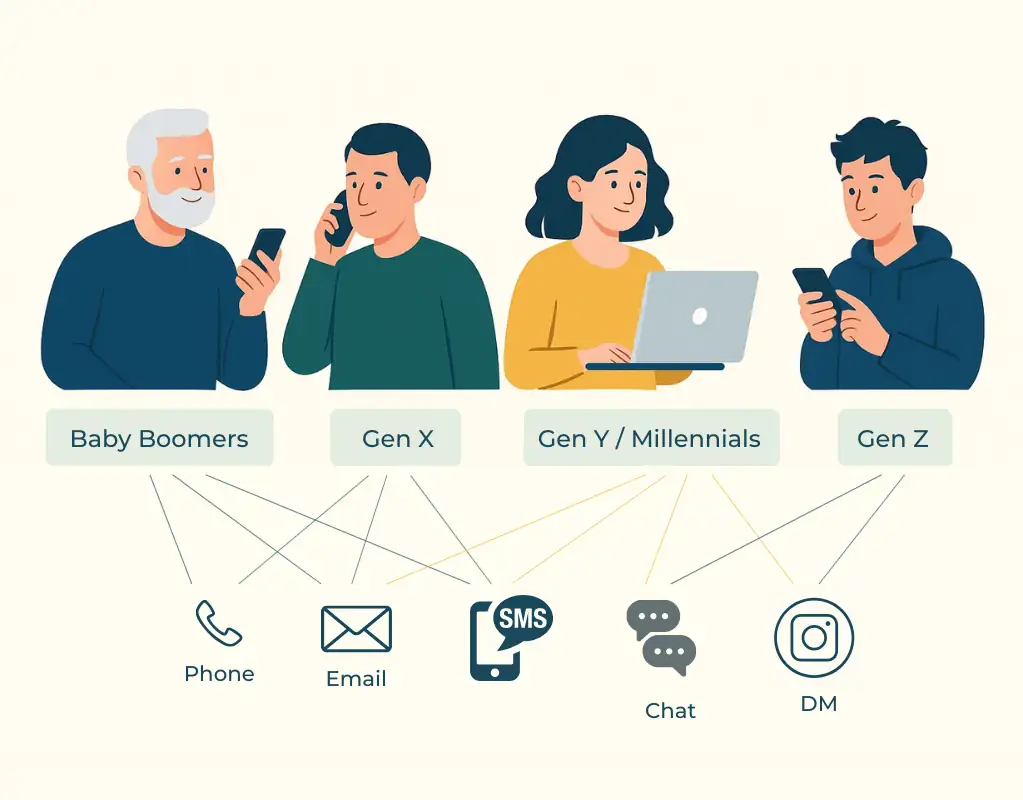How Different Generations Prefer to Communicate – Channels, Tone & Timing

⏱ Reading time: ~6 minutes
More and more businesses today face the challenge of speaking to multiple generations at once – and sounding relevant to each of them.
What You’ll Learn in This Article:
1. Communication Styles by Generation
2. Preferred Messaging Channels by Generation
3. What Breaks the Customer Connection
4. Personalization Preferences by Generation
5. Openness to New Messaging Formats
6. Automation That Feels Human
7. Who Makes Decisions – and What Do They Expect?
8. Conclusion: How, When, and Where You Say It Matters
FAQs
1. Communication Styles by Generation
Understanding generational communication habits isn’t just theory – it’s essential for stronger engagement and better results.
- Baby Boomers (1946–1964): value a respectful tone, consistent information, and a personal connection
- Gen X (1965–1980): look for clarity, choices, and fast responses
- Gen Y / Millennials (1981–1996): digitally native and open to tailored content
- Gen Z (1997–2012): expect instant, interactive, visually simple messages
2. Preferred Messaging Channels by Generation
The channel you use to reach your customers is often just as important as your message. Every format has its strengths – but different age groups respond differently. To make an impact, it’s crucial to align both what you say and how you deliver it.
|
Generation |
Preferred Channels |
|---|---|
|
Gen Z |
Mobile notifications, Chat, Instagram DMs, Video formats |
|
Gen Y |
Email, Chat, Social media, mobile messaging |
|
Gen X |
Email, Facebook, Phone, SMS |
|
Baby Boomers |
Phone, Email, Direct contact |
Younger generations lean toward fast, visual formats, while Gen X and Boomers tend to trust more traditional, proven methods.
Even a great message can fall flat if delivered through the wrong channel – or at the wrong time. In urgent or sensitive scenarios, direct messages that are visible and clear often outperform other formats.
📌 A good example from our practice: In a webinar campaign, a client used an email invite followed by a short SMS reminder just before the event. The response rate rose by 35% – especially among Gen X.
If you’re deciding which channels fit your strategy best, check out our comparison of SMS, Viber, and WhatsApp for business messaging.
3. What Breaks the Customer Connection
Strong content won’t help if it’s sent through the wrong medium – or lands at an inconvenient moment.
Common complaints include:
+ Messages arriving at the wrong time
+ Channels that feel awkward or unfamiliar
+ A tone that feels too generic or off-putting
🎯 Instead of sticking to a universal formula, it’s more effective to use automated messaging that adjusts frequency, tone, and delivery channel based on the audience.
4. Personalization Preferences by Generation
Every customer expects some level of personal treatment – but “personal” means different things for each generation:
|
Generation |
What Personalization Means |
|---|---|
|
Gen Z |
Short, Interactive messages |
|
Gen Y |
Content that saves time |
|
Gen X |
Facts and convenience |
|
Baby Boomers |
Phone, Email, Direct contact |
🔍 Example: In a re-engagement campaign, a client sent a personalized email linking to a helpful resource, followed by a simple SMS reminder. Results were 42% higher among Gen X and Gen Y.
Discover how personalization boosts engagement across segments.
5. Openness to New Messaging Formats
Gen Z and Gen Y are typically the first to embrace:
+ In-app messaging
+ Chatbots
+ Visual messages with buttons and interactive elements
📱 Rich Communication Services (RCS) combine text, visuals, and interaction in a single format. But:
+ Coverage is still inconsistent across carriers
+ Not all devices support it
+ Messages can be blocked or filtered by default
➡️ That’s why SMS and email remain reliable choices for important communications – especially when reach and predictability are key.
See how in-app, push, and web push channels compare in real campaigns.
06. Automation That Feels Human
People don’t want to chat with a robot – they want timely, helpful, and relevant answers. Good automation delivers that without feeling cold or scripted.
Common complaints include:
+ Send messages at just the right time
+ Adjust content based on customer behavior
+ Choose the best channel behind the scenes
📊 Campaigns with this level of personalization and timing often feel natural to the recipient – they get what they need, when and where they expect it.
Explore real-world SMS campaigns enhanced by automation.
07. Who Makes Decisions – and What Do They Expect?
Different generations influence both B2C and B2B decisions – in volume, context, and expectations.
Gen Y (Millennials) and Gen Z play a major role in digital-first purchases and are now involved in 70%+ of B2B buying decisions as well, especially in tech and service-driven industries.
Source: Forrester via Forbes – Younger B2B Buyers Have Taken the Reins
Gen X and Baby Boomers, however, still hold significant budget authority — particularly in industries like logistics, services, and finance.
So every campaign should reflect not just age – but role, context, and expectations.
Younger decision-makers (Gen Y, Gen Z) expect:
+ Digital access
+ Personal experiences
+ Fast response and interactivity
More experienced decision-makers (Gen X, Boomers) value:
+ Trust, reliability, and consistency
+ Clear value and proven performance
📍 The most effective strategies don’t split audiences by age – they align tone, timing, and delivery based on what each group truly needs.
Conclusion: It’s Not Just What You Say – It’s How, When, and Where You Say It
For each generation, it’s not just the message that matters – it’s how it’s delivered, when it arrives, and the tone it carries. The same text can have completely different effects depending on these factors.
🔑 Great communication happens when everything works in sync:
+ The right channel for the audience
+ Clear, helpful content tailored to context
+ Delivery that feels timely and relevant
+ Automation that feels personal – not robotic
📬 At ProCode, we help teams create messaging strategies that actually connect – channel by channel, generation by generation. Reach out if you’d like to see what this looks like in action.
Frequently Asked Questions
📝 All examples in this article were shared with client consent. We believe real cases best show the value of thoughtful communication.
